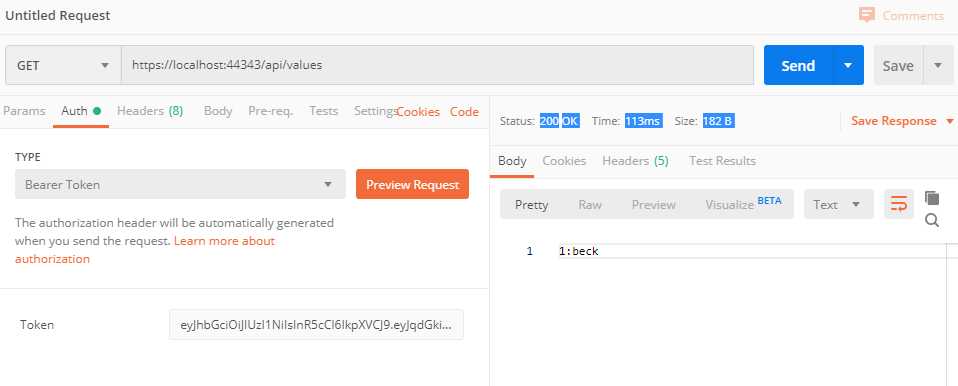在.NET Core中使用Jwt对API进行认证
2021-01-26 15:13
标签:option can min tde methods function lock xtext dem 在.NET Core中想用给API进行安全认证,最简单的无非就是Jwt,悠然记得一年前写的Jwt Demo,现在拿回来改成.NET Core的,但是在编码上的改变并不大,因为Jwt已经足够强大了。在项目中分为 DotNetCore_Jwt_Server 以及 DotNetCore_Jwt_Client ,从名字就可以看出来是啥意思,博客园高手云集,我就不多诉说,这篇博客就当是一篇记录。 当然本案例是Server&Client双项目,如果你要合成自己发证的形式,那你就自己改下代码玩。 在Server层都会有分发Token的服务,在其中做了用户密码判断,随后根据 Claim 生成 jwtToken 的操作。 其生成Token的服务代码: 在获取Token中我们依赖注入服务到控制器中,随后依赖它进行认证并且分发Token, 随后,我们又在项目配置文件中填写了几个字段,相关备注已注释,但值得说明的是有位朋友问我,服务器端生成的Token不需要保存吗,比如Redis或者是Session,其实Jwt Token是无状态的,他们之间的对比第一个是你的token解密出来的信息正确与否,第二部则是看看你 SecurityKey 是否正确,就这样他们的认证才会得出结果。 随后我们需要DI两个接口以及初始化设置相关字段。 在Client中,我一般会创建一个中间件用于接受认证结果,AspNetCore Jwt 源码中给我们提供了中间件,我们在进一步扩展,其源码定义如下: 其该扩展会返回一个 AuthenticateResult 类型的结果,其定义部分是这样的,我们就可以将计就计,给他来个连环套。 连环套直接接受 httpContext.AuthenticateAsync(JwtBearerDefaults.AuthenticationScheme) 返回回来的值,随后进行判断返回相应的Http响应码。 当然你也得在Client中添加认证的一些设置,它和Server端的 IssuerSigningKey 一定要对应,否则认证失败。 随后,你就可以编写带需认证才可以访问的API了,如果认证失败则会返回401的错误响应。 值得一提的是,我们可以根据 IHttpContextAccessor 以来注入到我们的Service或者Api中,它是一个当前请求的认证信息上下文,这将有利于你获取用户信息去做该做的事情。 在源码中该类的定义如下,实际上我们可以看到只不过是判断了当前的http上下文吧,所以我们得出,如果认证失败,上下本信息也是空的。 如果要通过js来测试代码,您可以添加请求头来进行认证,beforeSend是在请求之前的事件。 好了,今天就说到这,代码地址在https://github.com/zaranetCore/DotNetCore_Jwt 中。 在.NET Core中使用Jwt对API进行认证 标签:option can min tde methods function lock xtext dem 原文地址:https://www.cnblogs.com/ZaraNet/p/11976611.htmlnamespace DotNetCore_Jwt_Server.Services
{
public interface ITokenService
{
string GetToken(User user);
}
public class TokenService : ITokenService
{
private readonly JwtSetting _jwtSetting;
public TokenService(IOptions
public class ValuesController : ControllerBase
{
private readonly IUserService _userService;
private readonly ITokenService _tokenService;
public ValuesController(IUserService userService,
ITokenService tokenService)
{
_userService = userService;
_tokenService = tokenService;
}
[HttpGet]
public async Taskstring> Get()
{
await Task.CompletedTask;
return "Welcome the Json Web Token Solucation!";
}
[HttpGet("getToken")]
public async Taskstring> GetTokenAsync(string name, string password)
{
var user = await _userService.LoginAsync(name, password);
if (user == null)
return "Login Failed";
var token = _tokenService.GetToken(user);
var response = new
{
Status = true,
Token = token,
Type = "Bearer"
};
return JsonConvert.SerializeObject(response);
}
}
"JwtSetting": {
"SecurityKey": "d0ecd23c-dfdb-4005-a2ea-0fea210c858a", // 密钥
"Issuer": "jwtIssuertest", // 颁发者
"Audience": "jwtAudiencetest", // 接收者
"ExpireSeconds": 20000 // 过期时间
}
public void ConfigureServices(IServiceCollection services)
{
services.Configure
///
}
public class AuthMiddleware
{
private readonly RequestDelegate _next;
public AuthMiddleware(RequestDelegate next)
{
_next = next;
}
public async Task Invoke(HttpContext httpContext)
{
var result = await httpContext.AuthenticateAsync(JwtBearerDefaults.AuthenticationScheme);
if (!result.Succeeded)
{
httpContext.Response.StatusCode = (int)HttpStatusCode.Unauthorized;
await httpContext.Response.WriteAsync("Authorize error");
}
else
{
httpContext.User = result.Principal;
await _next.Invoke(httpContext);
}
}
}
public void ConfigureServices(IServiceCollection services)
{
services.AddHttpContextAccessor();
services.AddScoped
[Route("api/[controller]")]
[ApiController]
public class ValuesController : ControllerBase
{
private readonly IIdentityService _identityService;
public ValuesController(IIdentityService identityService)
{
_identityService = identityService;
}
[HttpGet]
[Authorize]
public async Taskstring> Get()
{
await Task.CompletedTask;
return $"{_identityService.GetUserId()}:{_identityService.GetUserName()}";
}
public class IdentityService : IIdentityService
{
private readonly IHttpContextAccessor _context;
public IdentityService(IHttpContextAccessor context)
{
_context = context;
}
public int GetUserId()
{
var nameId = _context.HttpContext.User.FindFirst("id");
return nameId != null ? Convert.ToInt32(nameId.Value) : 0;
}
public string GetUserName()
{
return _context.HttpContext.User.FindFirst("name")?.Value;
}
}
public class HttpContextAccessor : IHttpContextAccessor
{
private static AsyncLocal
beforeSend : function(request) {
request.setRequestHeader("Authorization", sessionStorage.getItem("Authorization"));
}

文章标题:在.NET Core中使用Jwt对API进行认证
文章链接:http://soscw.com/index.php/essay/47322.html